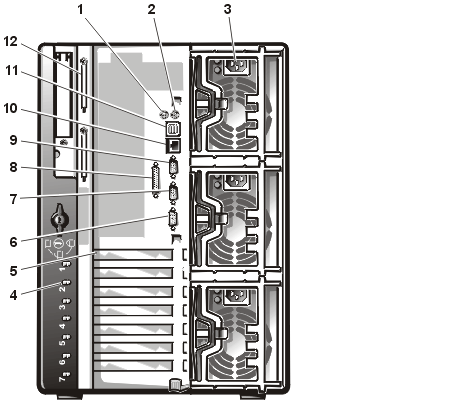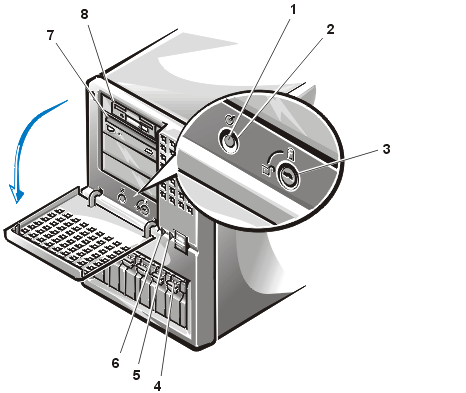| Overview | Look and Listen | ||
| Backing Up Files | The System Setup Program | ||
| Basic Checks | The Resource Configuration Utility | ||
| Checking Connections and Switches |
If your system is not working as expected, begin troubleshooting using the procedures in this section. This section guides you through some initial checks and procedures that can solve basic computer problems. It can also direct you to the appropriate section for detailed troubleshooting information and procedures to solve more complex problems.
| NOTE: When you see the question "Is the problem resolved?" in a troubleshooting procedure, perform the operation that caused the problem. |
If the system is behaving erratically, back up the files on the hard-disk drives immediately. See the documentation that came with the operating system for instructions on how to back up the files.
The following procedure leads you through the checks necessary to solve some basic computer problems:
Improperly set switches and controls and loose or improperly connected cables are the most likely source of problems for the computer, monitor, or other peripherals (such as a printer, keyboard, mouse, or other external equipment). A quick check of all the switches, controls, and cable connections can easily solve these problems. Figure 1 shows the back-panel connections on the computer. Figure 2 shows the front-panel controls and indicators on the computer.
Figure 1. Back-Panel Features
 |
|
Figure 2. Front-Panel Features
 |
|
To check all the connections and switches, perform the following steps:
Looking at and listening to the system is important in determining the source of a problem. Look and listen for the indications described in Table 1.
Table 1. Boot Routine Indications
| Look/Listen for: | Action |
|---|---|
| An error message | See "Messages and Codes." |
| Alert messages from the Dell OpenManage HIP software | The server management software has detected a problem inside the computer. See "Alert Log Messages From the Dell OpenManage HIP Application Program." |
| The monitor's power indicator | Most monitors have a power indicator (usually on the front bezel). If the monitor's power indicator does not come on, see "Troubleshooting the Monitor." |
| The keyboard indicators | Most keyboards have one or more indicators (usually in the upper-right corner). Press the <Num Lock> key, the <Caps Lock> key, or the <Scroll Lock> key to toggle their respective keyboard indicators on and off. If the indicators do not light up, see "Troubleshooting the Keyboard." |
| The diskette-drive access indicator | The diskette-drive access indicator should quickly flash on and off when you access data on the diskette drive. If the diskette-drive access indicator does not light up, see "Troubleshooting the Diskette Drive Subsystem." |
| The hard-disk drive activity indicators | The hard-disk drive activity indicators should quickly flash on and off when you access data on the hard-disk drives. On a system running the Microsoft® Windows NT® operating system, you can test the drive by opening Windows® Explorer and clicking the icon for drive C. If the hard-disk drive access indicator does not come on, see "Troubleshooting SCSI Hard-Disk Drives." |
| A series of beeps | See "System Beep Codes." |
| An unfamiliar constant scraping or grinding sound when you access a drive | Make sure the sound is not caused by the application program you are running. The sound could be caused by a hardware malfunction. See "Getting Help" for instructions on obtaining technical assistance from Dell. |
NOTE: For the full name of an abbreviation or acronym used in this table, see "Abbreviations and Acronyms."
You can easily correct certain system problems by verifying the correct settings in the System Setup program. When you boot the system, the system checks the system configuration information and compares it with the current hardware configuration. If the system hardware configuration does not match the information recorded by the System Setup program, an error message may appear on the screen.
This problem can happen if you changed the system's hardware configuration and forgot to run the System Setup program. To correct this problem, enter the System Setup program, correct the corresponding System Setup setting, and reboot the system. See "Using the System Setup Program" in the User's Guide for detailed instructions on using the System Setup program.
If you are experiencing problems with the system, you may have a conflict between the information stored by the System Setup program and the Resource Configuration Utility. Although the Resource Configuration Utility can read changes from the System Setup program, changes are not recorded into configuration memory until you run the Resource Configuration Utility and save the new information. See "Using the Resource Configuration Utility" in the User's Guide for detailed instructions on using the Resource Configuration Utility and saving new information.
If after using the Resource Configuration Utility you have not resolved the problem, see "Running the Dell Diagnostics."